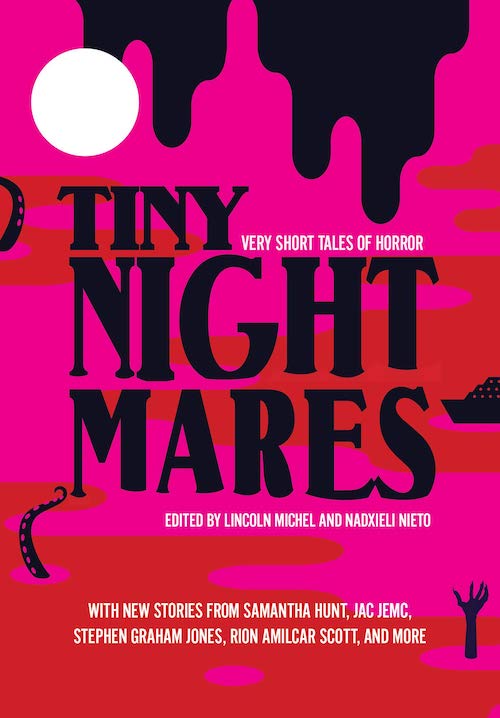For those of us struggling this year with the attention spans of gnats hopped up on cocaine, short stories can provide a reading refuge. Accordingly, Tiny Nightmares, the new collection from editors Lincoln Michel and Nadxieli Nieto, may turn out to be the perfect horror read for this season.
Just as they did previously in Tiny Crimes, Michel and Nieto have brought together a staggeringly varied set of 40+ works of flash fiction, written by an equally diverse cast of authors. These stories are short, sometimes jarringly so, and are filled with all sorts of spine-tingling frights.
There are vampires and werewolves, as you’d expect. There are also sinister subway rats and horrifying online dating encounters, as you might not. In these pages, there is also the occasional demon in a 1994 Gateway 2000, to delight and terrify you.
In a world in which each day seems to bring some new, unexpected terror, the unpredictability and volatility of Tiny Nightmare’s stories fit the mood, alternating between otherworldly supernatural and perfectly everyday horrors. More often than not, as in Stephen Graham Jones’ characteristically funny and frightening “Pincer and Tongue,” both are present.
For every demon and ghost, there is a horror more tangible and real, as in Rion Amilcar Scott’s “Jane Death Theory #13,” which does not have to supply much beyond the cold cruel facts of police brutality. Likewise, in Jac Jemc’s “Lone,” hell for a woman camping alone is mortal men.

Apple | Bookshop.org | Amazon | Barnes & Noble | IndieBound
Creature features mix with social commentary; blood splatter flecks bad marriages. Stories alternate between the unexplained and unimaginable. Pulling together all these loose strands is no easy task, but the collection coalesces seamlessly, largely because both editors and authors understand why we seek out stories that scare us: we are our fear.
“An argument can be made that fear made humans what we are,” Michel and Nieto write in their introduction. “Literally. Our eyes evolved to see monsters lurking in the grass, our ears to hear creatures going bump in the night. Fear is also, for better or (more often) worse, the dark force that shapes society.”
It’s no coincidence then that the collection is treated as a single body, categorizing its tiny, niggling horrors by their relationship to that body: Heads, Hearts, Limbs, Viscera.
The themes are evident. The stories of Heads ask us to question what our eyes see and our mind believes, as in Amrita Chakraborty’s wonderfully creepy “Twenty-First-Century Vetala,” narrated by a body-snatcher of Hindu folklore. In Limbs, the stories linger and take on a life of their own like the skeleton hand of Jei D. Marcade’s “#MOTHERMAYHEM.”
The playfully formatted “Human Milk for Human Babies” by Lindsey Miller and its tale of the neighbor you don’t know is a grand example of the grotesqueries of Viscera. Meanwhile, the Hearts stories force us to look at our fraught relationships with one another, probing the unease and anxieties within. My favorite of these is Selena Gambrell Anderson’s “Harold,” in which one girl’s tiny discovery is a perverse form of escapism.
That story, in particular, speaks to the entire collection. Longing to avoid lackluster parents, young Margo Childress strikes up a friendship with a tiny man in a tiny cave in the wall of her father’s library. Without revealing the plot, what starts as one relationship echoes on, in a never-ending chain — a nesting doll of peculiarities.
In the same way, Tiny Nightmares’s short, unsettling snippets ripple out, haunting the recesses of your mind far longer than their word count would suggest. They’re pervasive, these bite-sized horrors, possibly because they’re so personal. They understand what truly unsettles us — and they understand why we want to be unsettled.
“In the shadow of these larger systemic horrors, tiny nightmares breed,” Michel and Nieto write of our current reality. “These nightmares, masked and unmasked, provoke a deeper dread and implicate the reader. We are often the very thing another rightfully fears.”




Wow! That really looks like a creepy bunch of quick reads. Though I am not particularly fond of short stories, horror has been a genre that piques up my interest no matter the length of narration. Great to see some great authors in the collection and I’m waiting eagerly for my copy to arrive.